Photo 2). Another change for the 4.6L in 2006 is that it no longer uses a knock sensor. 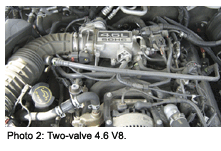 Both, the 4.0L and the 4.6L use a PCM-controlled heated PCV valve. The PCV valve on the 4.0L SOHC engine is located in the back of the left valve cover, mounted horizontally, and is well hidden from view as it is sandwiched between the valve cover and the firewall.
Both, the 4.0L and the 4.6L use a PCM-controlled heated PCV valve. The PCV valve on the 4.0L SOHC engine is located in the back of the left valve cover, mounted horizontally, and is well hidden from view as it is sandwiched between the valve cover and the firewall.
The 4.0L no longer uses an engine oil cooler, or a heated throttle body after 2006. The oil requirements of the 4.6L and the 4.0L remain the same as in the past. The 4.0L still uses 5W-30 with a five quart capacity, and the 4.6L still uses 5W-20 with a 6.5 quart capacity.
As of 2006, all models of Explorer and Mountaineer come standard with roll stability control (See Photo 3). RSC is also referred to as AdvanceTrac and Integrated Vehicle Dynamics (IVD).
 This system uses a yaw sensor to measure body roll, a steering angle sensor to measure rate of steering wheel movement, a brake pressure sensor to measure the driver’s brake pedal demand, and a lateral acceleration sensor to measure body acceleration and deceleration.
This system uses a yaw sensor to measure body roll, a steering angle sensor to measure rate of steering wheel movement, a brake pressure sensor to measure the driver’s brake pedal demand, and a lateral acceleration sensor to measure body acceleration and deceleration.
These inputs are to the ABS module, which already has traction control ability. With RSC/AdvanceTrac, the ABS/IVD module is now using ABS and traction control functions to control the amount of body roll in turns based on inputs from the yaw, steering angle, brake pressure and lateral acceleration sensors. The advantages of this system are most noticeable on wet or icy roads.
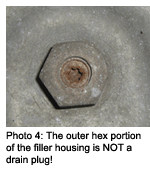 The 4.0L SOHC engines are coupled with a five-speed auto transmission — 5R55. The 5R55 transmission is a dipstick less design. In the bottom of the transmission pan is the fill port (See Photo 4). The filling is achieved by use of a fluid transfer tool that can pump the fluid up through the center of the filler housing after removal of the T-30 Torx screw. The outer hex portion of the filler housing is NOT a drain plug! The filler housing is not intended or designed to be removed. If the filler housing is removed, damage to the pan will most likely result. Though some people have been lucky and used the filler housing as a drain plug without damage, many more haven’t been so fortunate.
The 4.0L SOHC engines are coupled with a five-speed auto transmission — 5R55. The 5R55 transmission is a dipstick less design. In the bottom of the transmission pan is the fill port (See Photo 4). The filling is achieved by use of a fluid transfer tool that can pump the fluid up through the center of the filler housing after removal of the T-30 Torx screw. The outer hex portion of the filler housing is NOT a drain plug! The filler housing is not intended or designed to be removed. If the filler housing is removed, damage to the pan will most likely result. Though some people have been lucky and used the filler housing as a drain plug without damage, many more haven’t been so fortunate.
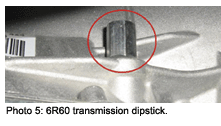 Often, the nut that is mounted inside the pan will tear away and cause a severe leak and pan damage without ever being able to remove the housing at all.
Often, the nut that is mounted inside the pan will tear away and cause a severe leak and pan damage without ever being able to remove the housing at all.
The traditional pan-drop is the intended draining method for the transmission. Filling is achieved at idle in park on a warm transmission. Simply fill the pan up through the T-30 bolt hole until the fluid runs back out when the tool is pulled away. Re-install the T-30 bolt when the fluid stops running back out of the hole. The fluid requirement is Mercon V.
The transmission behind the 4.6L is a six-speed auto trans — 6R60. The 6R60 transmission requires Mercon SP fluid. Use of Mercon V in a 6R60 can cause damage to the transmission. The 6R60 trans has a dipstick, but not in a traditional design of a dipstick. This transmission uses a mini-dipstick located on the passenger side of the transmission, toward the front of the trans, and just above the pan (See Photo 5 and 6).
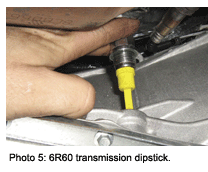 The metal sealing cap of the mini dipstick is a 19mm hex, and does pull out of the cap so that the technician can dip the stick straight into the fluid for measurement without having to repeatedly screw it in and out. Fluid level is critical on this transmission. The 6R60 transmission also uses an internal thermostatic valve that seriously interferes with the use of a cooler line type fluid exchange machine (flush machine). Flow through the cooler only occurs when allowed by the thermostatic valve. Therefore, a flush machine is only effective when the trans is hot enough to allow cooler line flow.
The metal sealing cap of the mini dipstick is a 19mm hex, and does pull out of the cap so that the technician can dip the stick straight into the fluid for measurement without having to repeatedly screw it in and out. Fluid level is critical on this transmission. The 6R60 transmission also uses an internal thermostatic valve that seriously interferes with the use of a cooler line type fluid exchange machine (flush machine). Flow through the cooler only occurs when allowed by the thermostatic valve. Therefore, a flush machine is only effective when the trans is hot enough to allow cooler line flow.
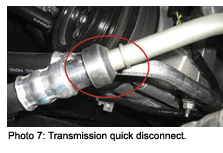 This may take a very long time to achieve, and Ford says that cooler line style machines are not compatible at all with this transmission. In order to be able to flush one of these transmissions, the vehicle will have to be driven at highway speeds, then returned immediately to the shop for hook up to the machine before the vehicle can cool. Then, periodic light power-braking will be needed to maintain the transmission’s temp until the fluid is exchanged. The only factory recommended service method is to lower the pan.
This may take a very long time to achieve, and Ford says that cooler line style machines are not compatible at all with this transmission. In order to be able to flush one of these transmissions, the vehicle will have to be driven at highway speeds, then returned immediately to the shop for hook up to the machine before the vehicle can cool. Then, periodic light power-braking will be needed to maintain the transmission’s temp until the fluid is exchanged. The only factory recommended service method is to lower the pan.
Over the last few years, a new quick connect has found its way into the Ford platforms (Photo 7). This new cooler line connection is found in two sizes, and both require a new tool to navigate the bubble flare found in the line near the connection (See photo 8). 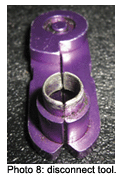 The tool pictured here is the smaller diameter, and more popular, of the required tools.
The tool pictured here is the smaller diameter, and more popular, of the required tools.
Exterior lighting on the 2006 Explorer and Mountaineer is controlled by the Smart Junction Box (SJB). The SJB is a fuse panel and a GEM module integrated into one single unit.
The 2006 and up Explorer and Mountaineer now use an electric viscous fan clutch. This is a mechanical fan clutch that the PCM has control over (See Photo 9). The wiring harness for this fan clutch routes between the spinning fan blades and the belt.
It is found on both engine options from 2006 and up. The fan clutch consists of three main parts — a working reservoir, a chamber and a clutch actuator. The reservoir stores fluid that is transferred back and forth between the reservoir and the chamber. The fluid movement between the two is controlled by the actuator.
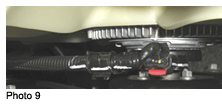 To speed the fan up, the actuator allows more fluid to pass from the reservoir to the chamber. In contrast, to slow the fan down, less fluid is allowed into the chamber. Once the fluid is inside the chamber, the energy transfer from the fan pulley to the blades is performed similar to that of what takes place inside of a torque converter. The actuator is controlled by Pulse Width Modulation (PWM) from the PCM.
To speed the fan up, the actuator allows more fluid to pass from the reservoir to the chamber. In contrast, to slow the fan down, less fluid is allowed into the chamber. Once the fluid is inside the chamber, the energy transfer from the fan pulley to the blades is performed similar to that of what takes place inside of a torque converter. The actuator is controlled by Pulse Width Modulation (PWM) from the PCM.
The wider the time frame that the actuator is pulsed “on,” the more fluid fills the chamber and therefore the more energy transfers from the pulley causing the fan to spin faster. The PCM monitors a fan speed sensor during closed loop operation, which is a hall effect sensor.
To diagnose the operation of the Viscous Fan Clutch, a scan tool with the ability to monitor the actuator command and the actual fan speed PIDs will be needed. An oscilloscope may also be needed to test the signal from the speed sensor as well as the PMW command from the PC to the clutch actuator.
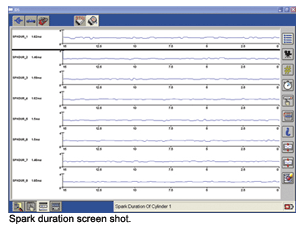 One nice new feature found on 2006 and up Explorer and Mountaineer models (as well as other Ford products) is the addition of spark duration PIDs in the PCM. (See Spark Duration screen shot.) Assuming your scan tool is capable, you will be able to view the burn time of each individual spark event on the scanner.
One nice new feature found on 2006 and up Explorer and Mountaineer models (as well as other Ford products) is the addition of spark duration PIDs in the PCM. (See Spark Duration screen shot.) Assuming your scan tool is capable, you will be able to view the burn time of each individual spark event on the scanner.
The burn time PIDs are not “calculated” duration times, but rather they are actual burn times. This is very helpful in ignition diagnostics because as secondary resistance increases, as in the case of overly worn spark plugs or a lean cylinder, the burn time will shorten. If secondary resistance lowers, as in the case of a fouled plug or low compression, the burn time will lengthen. Previously, the only real way to measure spark duration was by use of an oscilloscope.
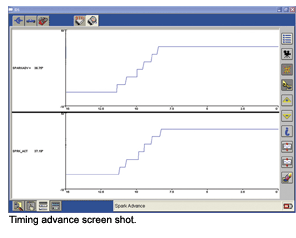 Currently, secondary KVs are not shown, but we can always hope that one day they will be. Another new ignition related PID is the “actual” timing advance PID. (See Timing Advance screen shot.) The “desired” or “calculated” timing advance is not new by any means, however the “actual” timing advance PID is. The difference is that the older timing advance PID, the desired timing advance, only reflects the command for timing advance that the PCM’s “thinking” portion is generating. The “actual” timing advance PID confirms if the “thinking” side’s desire for advance is being carried out.
Currently, secondary KVs are not shown, but we can always hope that one day they will be. Another new ignition related PID is the “actual” timing advance PID. (See Timing Advance screen shot.) The “desired” or “calculated” timing advance is not new by any means, however the “actual” timing advance PID is. The difference is that the older timing advance PID, the desired timing advance, only reflects the command for timing advance that the PCM’s “thinking” portion is generating. The “actual” timing advance PID confirms if the “thinking” side’s desire for advance is being carried out.
Odds and Ends
In 2006, the pressurized cooling system de-gas bottle has been replaced for a non-pressurized overflow tank.
Rear brake lining formula has changed in 2006 to meet the Federal Green Toxicology standards and also the 6,280-lb. weight rating.
The power steering reservoir is no longer mounted on the engine as of 2006. The 4.0L is mounted on the fan shroud and the 4.6L is mounted on the body.
The transmission control module (TCM) for the 5R55 is located inside the PCM.
The TCM for the 6R60 is located inside the transmission and is integrated with the valve body.
The 6R60 has full manual shift ability.
The 6R60 has a modified trans oil cooler and a three-plate torque converter with doubled friction clutch fluid flow to handle increased hauling capacities.







